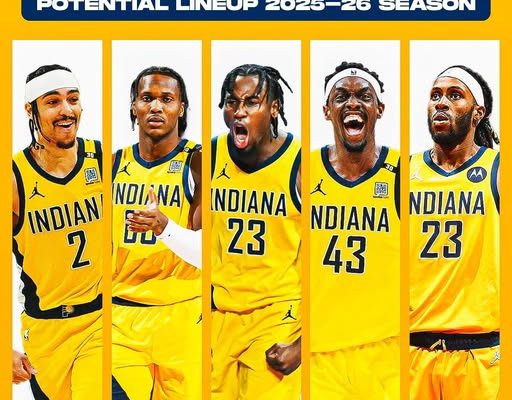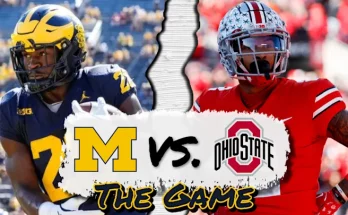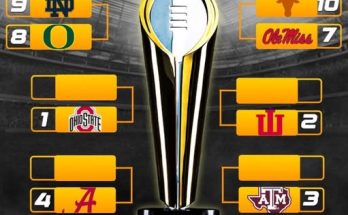Fresh off their exciting run to the 2025 NBA Finals, the Indiana Pacers enter the 2025–26 season in a state of emotional contradiction. On one hand, there’s an undeniable buzz surrounding a team that exceeded expectations and reintroduced Indiana basketball to the national stage with a mix of grit, speed, and youthful brilliance. On the other, there’s a looming sense of deflation and uncertainty. The heart and engine of their franchise—Tyrese Haliburton—will not be on the court. The news that the All-NBA point guard will miss the entire season due to a devastating Achilles injury has cast a long shadow over what was supposed to be a continuation of momentum. Yet in a league driven by resilience, next-man-up mentalities, and the unpredictable emergence of new stars, the Pacers are not folding their hand.
Haliburton’s injury is more than just the loss of statistical production—it’s a void in leadership, tempo, and identity. The 25-year-old orchestrator was the mind behind Indiana’s thrilling pace and transition-heavy offense. He averaged 21.7 points and 10.2 assists per game last season, but more importantly, he dictated how the Pacers played. Every screen, every off-ball cut, every fast break started with Haliburton’s decision-making. His ability to create efficient looks for himself and others was the reason Indiana became such a nightmare matchup for even elite defenses. During the playoffs, he raised his game even further, pushing the Pacers past Boston and Milwaukee before falling to a seasoned Denver Nuggets squad in the Finals. His vision and poise helped solidify Indiana as more than just an up-and-coming team—they were contenders.
Now, the franchise is left searching for answers. Not despairing, but recalibrating.
The responsibility to keep the Pacers competitive in Haliburton’s absence doesn’t fall to just one player, and that may be the team’s saving grace. Indiana’s roster is deep, hungry, and still developing. Bennedict Mathurin, now entering his third season, will likely be asked to expand his offensive role significantly. Mathurin showed flashes last season of becoming a three-level scorer and was pivotal in key playoff moments. With Haliburton sidelined, he’ll not only be expected to increase his scoring output but also to take on more playmaking responsibilities—a challenge he has openly embraced during offseason workouts and Team Canada exhibitions.
Meanwhile, Andrew Nembhard, a fellow Canadian and second-year point guard, becomes an immediate focal point. While Nembhard doesn’t have Haliburton’s flair or star power, he’s a steady and intelligent floor general. What he lacks in explosiveness he makes up for with decision-making, defense, and composure. During stretches of last season when Haliburton was sidelined with minor injuries, Nembhard filled in admirably, even recording double-digit assist games and holding his own against elite competition. The coaching staff has immense faith in his maturity and are prepared to put the ball in his hands from day one.
T.J. McConnell, a veteran guard who played a pivotal role off the bench during the Finals run, also figures to be a steadying presence. His leadership, defensive toughness, and ability to control tempo give the Pacers a baseline of competence at the guard position, even without their star. Head coach Rick Carlisle, known for getting the most out of his point guards, will need to get creative with his rotations and schemes to offset Haliburton’s absence, especially when it comes to initiating offense in half-court sets.
But where this team might surprise people isn’t just in the backcourt—it’s on the wings and in the frontcourt. Jarace Walker, the 2023 lottery pick who began to blossom during the second half of last season, is poised for a breakout campaign. At 6’8” with a versatile offensive package and an already elite defensive motor, Walker has the tools to become a two-way force. He showed during the playoffs an ability to guard multiple positions, switch effectively, and even act as a secondary ball handler in transition. Carlisle has hinted that Walker could be used in a Draymond Green-like role—facilitating offense from the high post and spearheading defensive rotations.
Veterans like Myles Turner and Pascal Siakam will be leaned on more heavily as well. Turner, who re-signed with the team last year on a team-friendly deal, continues to be one of the league’s best shot blockers and floor-spacing bigs. His ability to hit threes, anchor the paint, and switch defensively makes him invaluable, especially now that the margin for error has tightened. Siakam, acquired midway through last season in a deal with Toronto, brought championship experience and consistent scoring to Indiana. With Haliburton out, Siakam may have to take on a larger role as the primary offensive option, particularly in late-game scenarios. His post play, ability to drive, and mid-range game will be critical to keeping Indiana competitive in close contests.
The loss of Haliburton also places greater importance on the culture and chemistry that Carlisle and the front office have built over the past two seasons. This isn’t a locker room defined by ego or individual agendas. It’s a group of players who genuinely like playing with each other, share the ball, and compete with intensity. That kind of environment is what allowed them to make the Finals in the first place, despite being written off by most preseason projections. And it’s that same culture that gives them a fighting chance to weather this storm.
From a front-office perspective, the question becomes: Should the Pacers consider a trade to fill the Haliburton gap? As of now, the answer appears to be no. Team president Kevin Pritchard and general manager Chad Buchanan have made it clear they’re committed to internal development. Rather than mortgage future assets or disrupt the team’s budding chemistry, Indiana will use this season as both a test and an opportunity. The goal isn’t to tread water—it’s to discover new elements of their roster that can thrive even in adversity. If a move is made, it will likely be modest—a backup guard or an additional wing with playoff experience—but nothing drastic appears imminent.
One intriguing subplot to watch is the development of rookie guard Kanaan Carlisle, the undrafted dynamo from Stanford who lit up Summer League and quickly earned a two-way contract. Carlisle’s elite first step, tight handle, and confidence have caught the attention of both coaches and teammates. Though still raw, he may find minutes as a change-of-pace guard, especially if he continues to prove he can defend and shoot with consistency. His development could end up being one of the silver linings of Haliburton’s injury, as it allows the coaching staff more runway to experiment with young talent.
Ultimately, the Pacers find themselves in unfamiliar territory: trying to sustain contender status without the very player who brought them there. But rather than fall into despair, Indiana seems galvanized. They’re aware that no one outside the state expects them to replicate last year’s success, and they’re using that doubt as fuel. This isn’t the first time a team has had to redefine itself after a star goes down, and history shows that the right mix of talent, chemistry, and coaching can still make magic happen.
Tyrese Haliburton’s rehab will be closely watched, not just by Pacers fans but by the entire NBA community. Achilles injuries are among the most feared in sports, but medical advancements and the 25-year-old’s relentless work ethic offer hope. For now, he remains the emotional leader from the sidelines, attending practices, mentoring younger guards, and staying close to the team. His absence is deeply felt, but his presence is still very much part of the Pacers’ heartbeat.
The road ahead won’t be easy. The Eastern Conference remains brutal, with the Celtics, Heat, Knicks, and 76ers all reloading. But the Pacers believe they’ve built something sustainable—something more than a one-year wonder. While Haliburton’s injury is a setback, it’s also a call to arms for everyone else in the building to rise a little higher, push a little harder, and embrace the opportunity to grow.
In sports, adversity has a way of revealing truth. This season, the truth about the Indiana Pacers will be on full display—every game, every possession, every challenge. And if their Finals run taught us anything, it’s this: count them out at your own risk.



